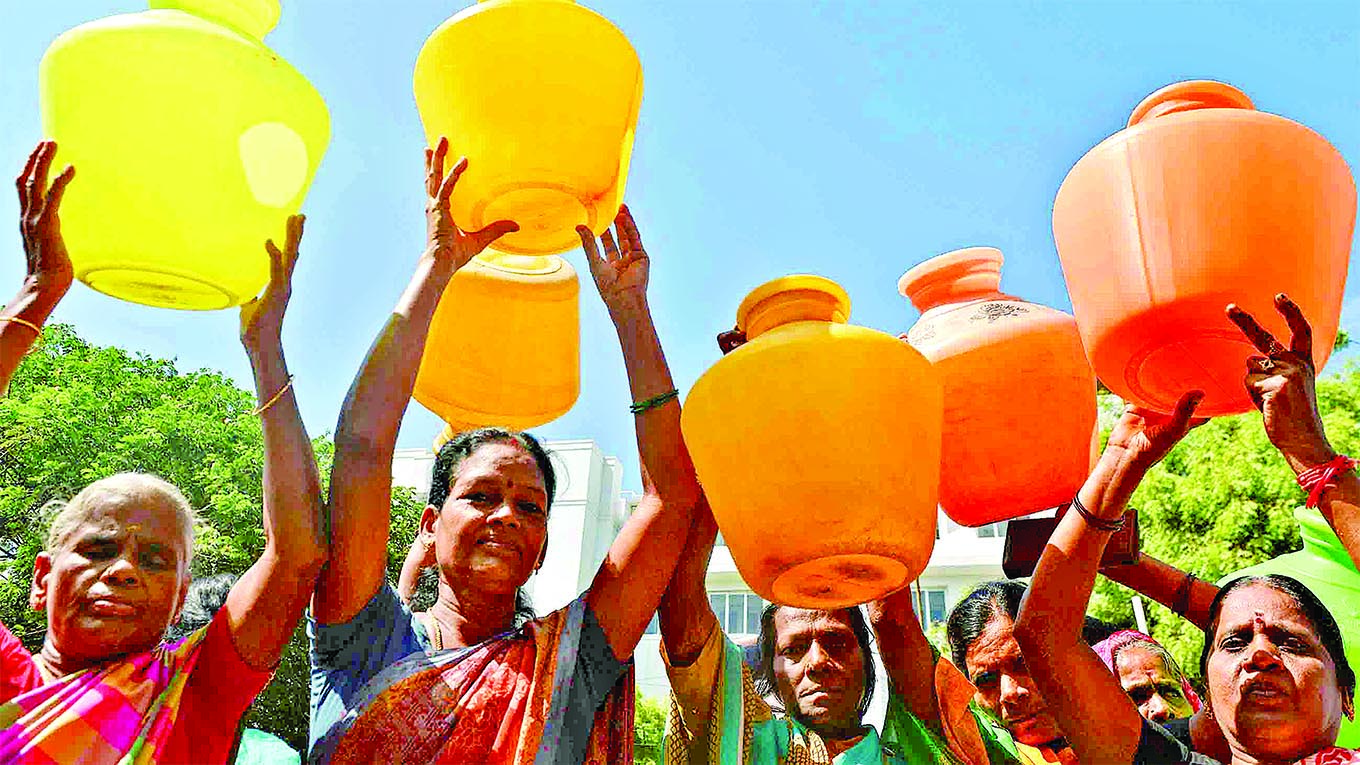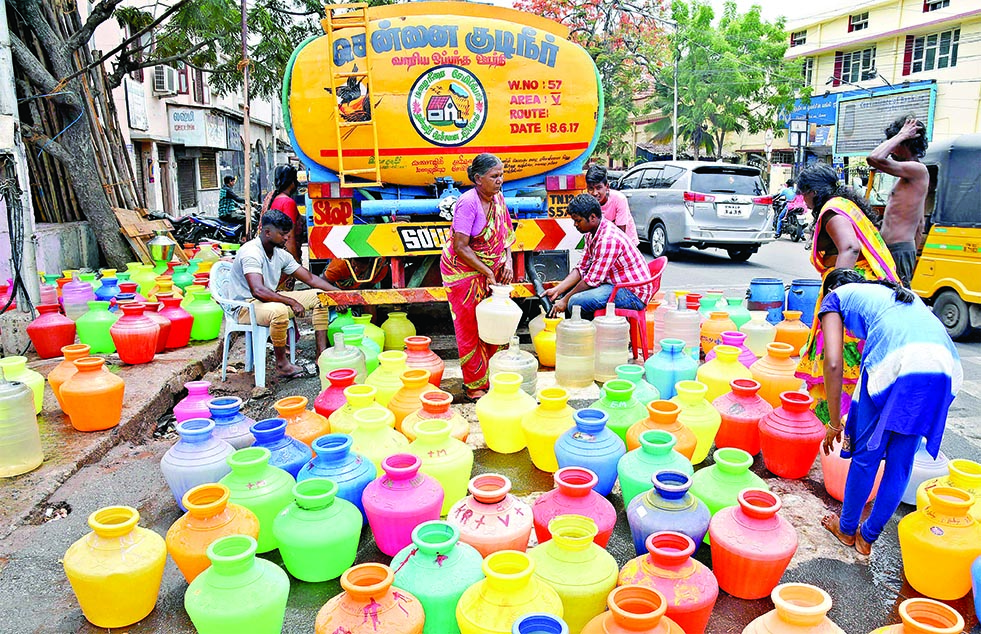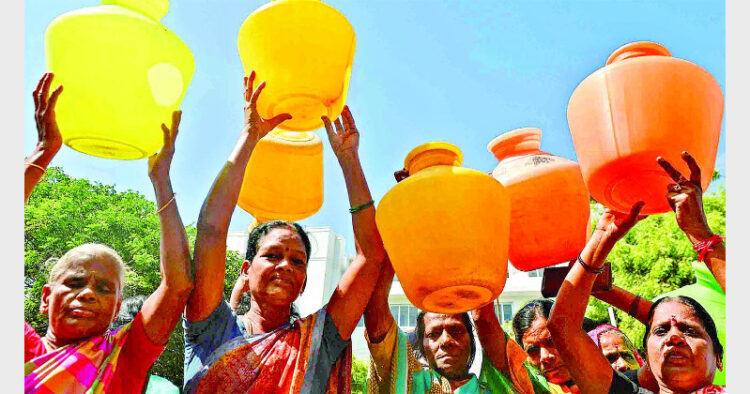Every year during Summer, Chennai is gasping for life for want of drinking water but the powers that be don’t care, as they get their water safely delivered home, while the hapless Chennaites have had to fend for themselves
Chennai’s on-going water crisis is purely man-made. And the blame not only rests squarely on the political leadership but also on the bureaucrats and engineers at the State level, over the past seven decades. Both the Dravidian parties – the DMK and AIDMK – and the Congress are squarely responsible for the periodic water crisis tormenting people of Chennai.

Let me briefly recall the basic planning data. From just over 14 lakhs population in 1951, the growth Chennai population, as per data available in 2019, the Chennai Metropolitan Area (CMA) is over 110 lakhs or 11 millions with density 26,903 per Sq. Km. With the planning figure of water per individual taken as 100 liters per day, the total requirement of water per day is approximately 1100 million liters per day. With the population increasing over the decades, the city has faced water shortages in the past also.
As of 2018, nearly 50 to 60 percent of the water supplied in Chennai and its suburbs is through private water tankers, which supply about 20,000 water tankers every day, sourced from areas such as Mambakkam, Tiruporur, Poonamallee, Ayapakkam, and Manjambakkam. About 80 percent of the households in the CMA consume packaged drinking water. About 20 million liters of packaged drinking water are sold in the city daily.
The CMA has 22 water courses to include: three rivers – the Cooum, the Adyar, and the Kosasthalaiyar; a canal; 16 minor waterways; and four reservoir tanks – Nungambakkam, Tamaraipakkam, Cholavaram lake and Red Hills lake combined capacity of 11,057 mcft. In all, the CMA has nearly 4,100 water bodies, with storage capacity of 150,000 million cubic feetChennai is expected to face a huge deficit of 713 million liters per day (MLD) as the demand is projected at 2,248 MLD and supply estimated at only 1,535 MLD in 2026. Chennai reportedly receives about 985 million liters per day (MLD) from various sources against the required amount of 1,200 MLD. It has historically relied on annual monsoon rains to replenish its water reservoirs. Water is supplied from various sources to include: Poondi reservoir, lakes at Red Hills, Chembarambakkam and Sholavaram; Cauvery water from Veeranam Lake; Krishna River from Andhra Pradesh; aquifers in Neyveli, Minjur and Panchetty; and desalination plants at Nemelli and Minjur.

Chennai is facing unprecedented drinking water crisis with Tamil Nadu registering 41 per cent rainfall shortage this summer
The CMA has 22 water courses to include: three rivers – the Cooum, the Adyar, and the Kosasthalaiyar; a canal; 16 minor waterways; and four reservoir tanks – Nungambakkam, Tamaraipakkam, Cholavaram lake and Red Hills lake combined capacity of 11,057 mcft). In all, the CMA has nearly 4,100 water bodies, with storage capacity of 150,000 million cubic feet.
But, the rivers, the canal and waterways are polluted with sewage. As per experts, even the expanse of water bodies in and around Chennai contracted from 12.6 square kilometers in 1893 to 3.2 square kilometers in 2017. There were about 60 large water bodies in the Chennai area at one time, but as of 2017, they have come down to just 28, most of which are small. As of 2017, the total volume of water harvested was 339 mcft and groundwater recharge was 170 mcft. No longer, Chennai can depend on ground water supplies.
According to the records of the Water Resources Department, only 19 of the 28 major water bodies in the city’s periphery can be restored. Nine lakes cannot be rejuvenated owing to encroachments. Once rejuvenated completely, the remaining lakes will have a combined storage capacity of 1,000 million cubic feet (mcft). In addition, if the four primary reservoirs are desilted by a meter, an additional water volume of about 500 mcft can be stored.
There are four seawater Desalination plants to include: Minjur plant commissioned in July 2010 with a capacity of 100mld; Nemmeli Desalination Plant commissioned in February 2013 with a capacity of 100 mld; also at the existing Nemmeli plant with a capacity of 150 MLD (cost 1,372 crore); and, Perur desalination plant with a capacity of 400 million liters a day in 2018.
Among the future projects include: storage capacity of 1 TMC ft each at Thervaikandigai, Thirukandalam and Ramanjeri by 1 TMC ft each; and 0.9 TMC ft by restoring six tanks, namely, Nemam, Porur, Iyambakkam, Ambattur, Korattur and Madhavaram; and a further 0.3 TMC ft by deepening the Cholavaram tank. Thervoykandigai Reservoir proposal of November 2012 is awaiting clearance from the Union ministry of environment and forests. So it is abundantly clear even to a layman that Chennai faces water shortages are entirely man-made due to apathy of political leaders, bureaucrats and engineers.
Are there any answers to Chennai’s chronic water crisis? Yes. Desalination of sea water is the answer. Chennai decision makers and planers must follow the examples of Singapore, Israel and the USA.
For example, water supply and sanitation in Singapore – population of over 58 lakhs – is characterized by a number of achievements. Holistic approach to water resources management is the strategy that emphasizes on proper legislation and enforcement, water pricing, public education as well as research and development. Access to water is universal, affordable, efficient and of high quality. Innovative integrated water management approaches such as the reuse of reclaimed water, the establishment of protected areas in urban rainwater catchments and the use of estuaries as freshwater reservoirs have been introduced along with seawater desalination.
Singapore focus is on desalination plants starting with the first one in September 2005 – Sing Spring Desalination Plant, in Tuas producing 30 million imperial gallons (140,000 m3) of water each day that meets 10% of the country’s water needs. The second plant launched in June 2010 which began its operations two years later in 2013 has a capacity of 70 million imperial gallons (320,000 m3) per day. Together, desalinated water meets up to 25% of Singapore’s current water needs as of 2015.
The government has identified five coastal sites for future plants, with the objective of bringing the installed capacity to one million m³ per day, so that desalination will be able to meet up to 30% of Singapore’s future water demand by 2060.
Next, Israel, starting from 2002, has commissioned four large seawater desalination plants along the Mediterranean coast that supply 500 million m3/yr. The government’s goal is to reach a capacity of 750 million m3/year by 2020. All projects are executed by the private sector, through international tenders. The Ashkelon seawater reverse osmosis (SWRO) desalination plant was the largest in the world when it was commissioned. The project was developed as a BOT (Build-Operate-Transfer) by a consortium of three international companies: Veolia water, IDE Technologies and Elran.
Also, in USA, the oil-producing regions of Texas and California have a number of desalination plants catering to the needs of the population. Even Florida has also desalination water plants. The price of supplying water is around US$3.00 for 5000 liters, which compared to costs in India (Rs.1,000 per tanker), is significantly low.
At present, according to the International Desalination Association’s (IDA) 31st desalination inventory (which covers July 2017-June 2018), the total global installed desalination capacity stands at 97.4 million m3/d while the total global cumulative contracted capacity is 104.7 million m3/d. As of June 30, 2018, over 20,000 desalination plants had been contracted around the world.
“IDA always advocated solutions to water scarcity by supporting the development of the desalination and water reuse industry to secure sustainable water and natural resources. Over the past decades, our industry has achieved an important reduction in non-conventional water costs and increased quality to ensure water sustainability,” stated Miguel Angel Sanz, IDA President.
“As climate change continues to impact our world, along with industrial and population growth, the demand for clean water increases. Desalination and water reuse: non-conventional, environmentally sound water supply solutions are in keeping with the circular water economy and offer solutions to water scarcity. The trends we are seeing point to a broad recognition that these advanced water treatment solutions are essential to the health and well-being of people and economies around the world, both now and in the future,” said Shannon McCarthy, IDA Secretary General.
“The big breakthrough in the past year has been on the cost of desalination,” commented Christopher Gasson, Publisher at GWI. Recent project tenders in Saudi Arabia and Abu Dhabi have seen the price fall below $0.50/m3 for the first time. The expected surge in desalination is largely a result of gathering momentum in construction plans in the Middle East, especially the GCC countries. According to the 2018-2019 IDA Water Security Handbook, 1.9 million cubic meters per day (m3/day) of seawater capacity was contracted in the first half of 2018, up 26% over the same period in 2017.
However, not all the contracted large seawater plants are located in the Middle East. The largest seawater desalination award listed in the 31st desalination inventory is the 378,000 m3/d seawater reverse osmosis (SWRO) project in Rosarito, Mexico. This was followed by projects at Hamriyah (Sharjah, UAE, and 272,760 m3/d), Shoaiba 3 expansion 2 IWP (Saudi Arabia, 250,000 m3/d) and Al Khobar (Saudi Arabia, 210,000 m3/d).
Viewed in a holistic perspective, particularly with Chennai facing currently huge deficit of 713 million liters per day (MLD) and the demand projected at 2,248 MLD and supply estimated at only 1,535 MLD in 2026, there is no alternative but to opt for large number of desalination plants on “High Priority” or “Emergent” basis with assistance from the IDA based on BOT (Build-Operate-Transfer) by the consortium of three international companies – Veolia water, IDE Technologies and Elran – with foreign financial aid.
Not only is the above option applicable to Chennai but also to other coastal cities facing chronic “Water Crisis” situations.
(The writer is a Political Analyst)













Comments